2013 Instructor Interview - Debora Mauser
Discover Jewelry with Debora Mauser
Debora Mauser's a friendly, funny lady and a great jewelry designer, too! Debora loves to learn from her students and she's got a lot of great ideas to share with you. Plus, she talks about how to enamel onto wire: it's really not that hard! (She's teaching 2 enameling classes, see the Squiggly projects below).
Debora sat down for an interview with Heather, our Classes Coordinator, to talk about her wire wrapped and metal jewelry - click the button below to listen in. Or, scroll down to read a complete transcript!
(audio not playing? click here)
Explore Debora's Classes this February in Tucson:
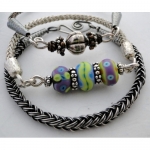 Cool to be Square Feb. 2, morning  |
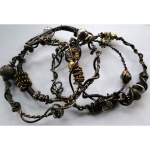 Wild Woman Bangles 2 chances to take this class: Feb 2, afternoon  Feb 7, morning  |
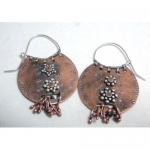 Tribal Copper Earrings Feb 3, full-day  |
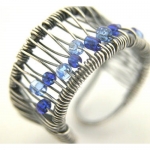 Abacus Ring 2 chances to take this class: Feb 4, morning  Feb 7, afternoon  |
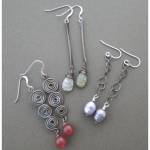 Earrings Galore Feb 4, afternoon  |
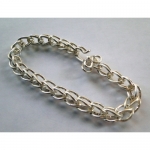 Foxtail Bracelet Feb 5, morning  |
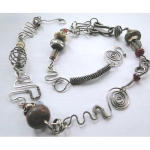 Luscious Links Feb 5, afternoon  |
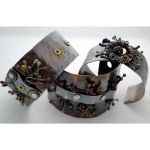 Squiggly Cuff Bracelet Feb 6, morning  |
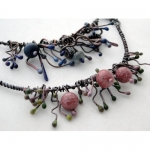 Squiggly Necklace Feb 6, afternoon  |
Transcript of our interview with Debora Mauser
Heather: Hello everybody! We're on the phone with Debora Mauser, how are you?
Debra: Just fine, thanks!
Heather: She will be teaching with us in Tucson and I think that everybody needs to come take a class from her. Let's start off the interview with what medium you primarily work in?
Debra: My main medium is wire. I started with beading but I love wire because of the different techniques and texture and shapes that I can create with different gauges, and half-round, square, copper, silver, brass. It just gives me unlimited access to new ideas.
Heather: Yeah! Lots of possibilities there! What are the tools you most often use?
Debora: My favorite tool are my Lindstrom pliers; my round nose pliers are used every day. Anything that fits easily in my hand that I can control, that's a hint I give all of my students: buy the pliers that fit in their hands. Some people have larger hands, some have smaller, but if you're a wireworker, the most important tools are your pliers.
Heather: Absolutely. Have you ever improvised or repurposed a tool?
Debora: I have. I use the smallest cylinder part of a dapping block (the metal thing) - I use that when I'm doing cold connections if I want to use a tube. I use that to spread and flair the end of the tube so I can have a tube rivet.
Heather: What is your favorite way to finish a piece or your favorite effect?
Debora: I use liver of sulfur on almost everything I do. I really like for the texture that I'm making, whether it's with wire-wrapping or etching, to show. I think a dark patina gives it an earthy feel and shows off the texture the best.
Heather: What advice would you give to a beginner who's maybe a bit intimidated by how intricate the process seems?
Debora: I don't think the process is intricate. If you take it step-by-step, learn to make a loop, learn to make a closed loop, then make larger loops; moving on is important, and stretching yourself is important.
Read as much as you can, take classes any time that you can. I always feel like when I take a class - and I still try to take as many as possible - if I learn one small hint, it's worth my time and my money, because that's going to make me a better artist, and that's what you have to look for, is a way to express yourself in your art.
Heather: Once you make a piece that you're happy with, where does it go?
Debora: That just depends, I do sell online but the first piece that I make of any new technique, I keep myself, because that is where my inspiration comes from. I try to go from that and then develop that thought process into more detailed pieces.
I do give a lot as gifts; you can ask my sister, she has hundreds of pieces! It just depends on what I'm making.
Heather: What gives you inspiration to try new things and what keeps you motivated?
Debora: I think my muse takes a break sometimes, but anything can set it off. Architecture, colors in the outdoors, shapes, anything like that can get you going. I do a lot of drawing and just kind of doodle and take that and kind of go with that form and see where it takes me.
Heather: Have you ever rescued a piece that seemed like it was broken?
Debora: I don't know if I could say it was broken, but I've certainly re-designed many pieces over the time that I've been making jewelry. Something I've thought was wonderful 10 years ago, I look at it now and think it needs something new. So I will take older pieces and rework them.
Heather: We've heard a lot about your Wild Woman Bangle, what makes this class so popular? Can you tell me a little bit about this bracelet and how it turns out different for each person every time?
Debora: Sure. That's one of my favorite classes; probably my signature class. I developed that with all the little pieces of wire left over at my work station: 3 inches of this, 6 inches of that.
I incorporate large hole beads and a lot of stuff from the hardware store, so every time I teach this, every person's esthetic is different. I do try to teach negative and positive space so your eye has a place to rest, but when people make their own wire beads and then do coiling and wrapping we all have a different esthetic. So even though I'm teaching the same technique, when you put those together in your way, they all turn out differently.
Heather: So you've been making and teaching jewelry for several years, what have you noticed about your work that's evolved?
Debora: I think I'm doing more intricate stuff. Even though wire is my first love, I am doing a lot of metalwork, cold connections, and a lot of enameling, but as I do this work, that work I always go back to is wire. Whether it's adding wire connections to an enameled piece, or weaving the two together, it seems like wire is the main force in my work. It develops, but it's constant.
Heather: Does it ever get easier to get ideas, and how do you keep your designs fresh and exciting for you?
Debora: I don't think it gets easier. I think you have to keep your eyes open and your mind open to what the universe is telling you. I have a lot of friends that are in the same business I am, and so we feed off of each other. We might take a design and each of us tries to make it differently.
I love to read magazines and see what the new trends are: whether it's color, or shape, and then I use that when I'm trying to create new things.
Heather: Can you tell me a little bit how you enamel wire like some of your classes show? Is it really complicated with really hard to find materials or is there a trick to it?
Debora: It's not complicated at all. It only takes a few minutes to learn how to enamel but it probably takes a lifetime to because an expert at it.
Enamel is just a powdered glass that you heat and it will fuse to metal. Within five minutes I can have people enameling.
The color selection is immense and you can combine colors to do unique and different things as well as different techniques. The basic classes that I'm teaching in Tucson is enameling head pins and using those in design. I think that's a perfect way for people to get start.
The product itself is not hard to find at all. There are tons of enamels here in the United States. You can find it in many sources and it's not that expensive to get into if you use a small butane torch.
Heather: What's something you've learned from one of your students?
Debora: Oh, my students are great, they teach me something all the time. One of the classes that I teach is "Cool to Be Square," which is a braided bracelet. We use 16 pieces of wire and taught it using blue tape to hold the ends together into different sections. Well, when you weave you always have to keep the right on the right, the left on the left. One of my students said "Why don't we use two different colors of tape, that way the blue is always on the right and the purple is always on the left?" It was like a lightbulb moment, and so now that's what we do!
Heather: So you've taught across the country, what have you taken away from those experiences?
Debora: It's interesting how we're all the same and we're all different. I can teach the same class all the way across the country from the East coast to the West coast, and you never know who is going to show up and what their esthetic is. I find that it's very enlightening to see that we all want to learn and incorporate new designs into what we're doing - I feed on that. Having that input from students is probably, referring back to your earlier question, is probably one of my biggest influences is when I talk to students and we brainstorm and get new ideas. It's very exciting.
Heather: That's so great. I thank you so much to take the time. That concludes my questions. Everybody needs to come and check out a class from you in Tucson and gain more knowledge.
Debora: I would love to meet new people out there. That's so exciting to me.
Heather: Thank you so much Debora, appreciate your time.
Debora: Thank you!
Don't Miss Debora in Tucson!
 Cool to be Square Feb. 2, morning  |
 Wild Woman Bangles 2 chances to take this class: Feb 2, afternoon  Feb 7, morning  |
 Tribal Copper Earrings Feb 3, full-day  |
 Abacus Ring 2 chances to take this class: Feb 4, morning  Feb 7, afternoon  |
 Earrings Galore Feb 4, afternoon  |
 Foxtail Bracelet Feb 5, morning  |
 Luscious Links Feb 5, afternoon  |
 Squiggly Cuff Bracelet Feb 6, morning  |
 Squiggly Necklace Feb 6, afternoon  |


 My Cart (Empty)
My Cart (Empty) 


